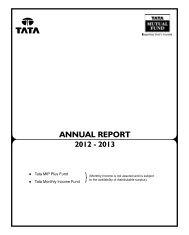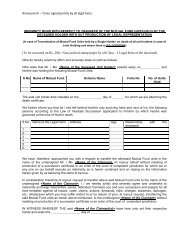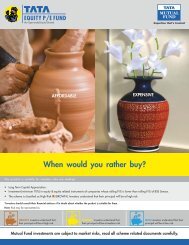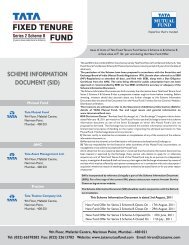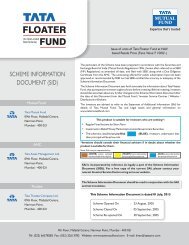- Page 1 and 2:
annual report 2011 - 2012 • TATA
- Page 3 and 4:
REPORT OF THE TRUSTEE TO THE UNITHO
- Page 5 and 6:
Act, 1882 and is duly registered un
- Page 7 and 8:
* On 31st December 2008, the units
- Page 9 and 10:
Sr No Scheme / Plan Name Date of al
- Page 11 and 12:
Redressal of Complaints received ag
- Page 13 and 14:
Name of the Company / Issuer Date o
- Page 15 and 16:
Name of the Company / Issuer Date o
- Page 17 and 18:
Name of the Company / Issuer Date o
- Page 19 and 20:
Name of the Company / Issuer Date o
- Page 21 and 22:
AUDITORS’ REPORT TO THE BOARD OF
- Page 23 and 24:
AUDITORS’ REPORT TO THE BOARD OF
- Page 25 and 26:
AUDITORS’ REPORT TO THE BOARD OF
- Page 27 and 28:
AUDITORS’ REPORT TO THE BOARD OF
- Page 29 and 30:
AUDITORS’ REPORT TO THE BOARD OF
- Page 31 and 32:
AUDITORS’ REPORT TO THE BOARD OF
- Page 33 and 34:
AUDITORS’ REPORT TO THE BOARD OF
- Page 35 and 36:
AUDITORS’ REPORT TO THE BOARD OF
- Page 37 and 38:
AUDITORS’ REPORT TO THE BOARD OF
- Page 39 and 40:
AUDITORS’ REPORT TO THE BOARD OF
- Page 41 and 42:
AUDITORS’ REPORT TO THE BOARD OF
- Page 43 and 44:
AUDITORS’ REPORT TO THE BOARD OF
- Page 45 and 46:
AUDITORS’ REPORT TO THE BOARD OF
- Page 47 and 48:
AUDITORS’ REPORT TO THE BOARD OF
- Page 49 and 50:
AUDITORS’ REPORT TO THE BOARD OF
- Page 51 and 52:
AUDITORS’ REPORT TO THE BOARD OF
- Page 53 and 54:
AUDITORS’ REPORT TO THE BOARD OF
- Page 55 and 56:
AUDITORS’ REPORT TO THE BOARD OF
- Page 57 and 58:
AUDITORS’ REPORT TO THE BOARD OF
- Page 59 and 60:
Balance Sheet of Tata Fixed Income
- Page 61 and 62:
Tata Fixed Income Portfolio Fund -
- Page 63 and 64:
Tata Fixed Income Portfolio Fund -
- Page 65 and 66:
Tata Fixed Income Portfolio Fund -
- Page 67 and 68:
Revenue Account of Tata Fixed Incom
- Page 69 and 70:
Tata Fixed Income Portfolio Fund -
- Page 71 and 72:
Tata Fixed Income Portfolio Fund -
- Page 73 and 74:
Tata Fixed Income Portfolio Fund -
- Page 75 and 76:
Revenue Account of Tata Fixed Incom
- Page 77 and 78:
Tata Fixed Income Portfolio Fund -
- Page 79 and 80:
Tata Fixed Income Portfolio Fund -
- Page 81 and 82:
Tata Fixed Income Portfolio Fund -
- Page 83 and 84:
Revenue Account of Tata Fixed Incom
- Page 85 and 86:
Tata Fixed Income Portfolio Fund -
- Page 87 and 88:
Tata Fixed Income Portfolio Fund -
- Page 89 and 90:
Tata Fixed Income Portfolio Fund -
- Page 91 and 92:
Revenue Account of Tata Fixed Incom
- Page 93 and 94:
Tata Fixed Income Portfolio Fund -
- Page 95 and 96:
Tata Fixed Income Portfolio Fund -
- Page 97 and 98:
Tata Fixed Income Portfolio Fund -
- Page 99 and 100:
Revenue Account of Tata Fixed Incom
- Page 101 and 102:
Tata Fixed Income Portfolio Fund -
- Page 103 and 104:
Tata Fixed Income Portfolio Fund -
- Page 105 and 106:
Tata Fixed Income Portfolio Fund -
- Page 107 and 108:
Revenue Account of Tata Fixed Incom
- Page 109 and 110:
Tata Fixed Income Portfolio Fund Sc
- Page 111 and 112:
Tata Fixed Income Portfolio Fund Sc
- Page 113 and 114:
Tata Fixed Income Portfolio Fund Sc
- Page 115 and 116:
Revenue Account of Tata Fixed Matur
- Page 117 and 118:
Tata Fixed Maturity Plan - Series 3
- Page 119 and 120:
Tata Fixed Maturity Plan - Series 3
- Page 121 and 122:
Tata Fixed Maturity Plan - Series 3
- Page 123 and 124:
Revenue Account of Tata Fixed Matur
- Page 125 and 126:
Tata Fixed Maturity Plan - Series 3
- Page 127 and 128:
Tata Fixed Maturity Plan - Series 3
- Page 129 and 130:
Tata Fixed Maturity Plan - Series 3
- Page 131 and 132:
INCOME Revenue Account of Tata Fixe
- Page 133 and 134:
Tata Fixed Maturity Plan - Series 3
- Page 135 and 136:
Tata Fixed Maturity Plan - Series 3
- Page 137 and 138:
Tata Fixed Maturity Plan - Series 3
- Page 139 and 140:
Revenue Account of Tata Fixed Matur
- Page 141 and 142:
Tata Fixed Maturity Plan - Series 3
- Page 143 and 144:
Tata Fixed Maturity Plan - Series 3
- Page 145 and 146:
Tata Fixed Maturity Plan - Series 3
- Page 147 and 148:
Revenue Account of Tata Fixed Matur
- Page 149 and 150:
Tata Fixed Maturity Plan - Series 3
- Page 151 and 152:
Tata Fixed Maturity Plan - Series 3
- Page 153 and 154:
Tata Fixed Maturity Plan - Series 3
- Page 155 and 156:
Revenue Account of Tata Fixed Matur
- Page 157 and 158:
Tata Fixed Maturity Plan - Series 3
- Page 159 and 160:
Tata Fixed Maturity Plan - Series 3
- Page 161 and 162:
Tata Fixed Maturity Plan - Series 3
- Page 163 and 164:
Revenue Account of Tata Fixed Matur
- Page 165 and 166:
Tata Fixed Maturity Plan - Series 3
- Page 167 and 168:
Tata Fixed Maturity Plan - Series 3
- Page 169 and 170:
Tata Fixed Maturity Plan - Series 3
- Page 171 and 172:
INCOME Revenue Account of Tata Fixe
- Page 173 and 174:
Tata Fixed Maturity Plan - Series 3
- Page 175 and 176:
Tata Fixed Maturity Plan - Series 3
- Page 177 and 178:
Tata Fixed Maturity Plan - Series 3
- Page 179 and 180:
Revenue Account of Tata Fixed Matur
- Page 181 and 182:
Tata Fixed Maturity Plan - Series 3
- Page 183 and 184:
Tata Fixed Maturity Plan - Series 3
- Page 185 and 186:
Tata Fixed Maturity Plan - Series 3
- Page 187 and 188:
Revenue Account of Tata Fixed Matur
- Page 189 and 190:
Tata Fixed Maturity Plan - Series 3
- Page 191 and 192:
Tata Fixed Maturity Plan - Series 3
- Page 193 and 194:
Tata Fixed Maturity Plan - Series 3
- Page 195 and 196:
Revenue Account of Tata Fixed Matur
- Page 197 and 198:
Tata Fixed Maturity Plan - Series 3
- Page 199 and 200:
Tata Fixed Maturity Plan - Series 3
- Page 201 and 202:
Tata Fixed Maturity Plan - Series 3
- Page 203 and 204:
Revenue Account of Tata Fixed Matur
- Page 205 and 206:
Tata Fixed Maturity Plan - Series 3
- Page 207 and 208:
Tata Fixed Maturity Plan - Series 3
- Page 209 and 210:
Tata Fixed Maturity Plan - Series 3
- Page 211 and 212:
Revenue Account of Tata Fixed Matur
- Page 213 and 214:
Tata Fixed Maturity Plan - Series 3
- Page 215 and 216:
Tata Fixed Maturity Plan - Series 3
- Page 217 and 218:
Tata Fixed Maturity Plan - Series 3
- Page 219 and 220:
Revenue Account of Tata Fixed Matur
- Page 221 and 222:
Tata Fixed Maturity Plan - Series 3
- Page 223 and 224:
Tata Fixed Maturity Plan - Series 3
- Page 225 and 226:
Tata Fixed Maturity Plan - Series 3
- Page 227 and 228:
Revenue Account of Tata Fixed Matur
- Page 229 and 230:
Tata Fixed Maturity Plan - Series 3
- Page 231 and 232:
Tata Fixed Maturity Plan - Series 3
- Page 233 and 234:
Tata Fixed Maturity Plan - Series 3
- Page 235 and 236:
Revenue Account of Tata Fixed Matur
- Page 237 and 238:
Tata Fixed Maturity Plan - Series 3
- Page 239 and 240:
Tata Fixed Maturity Plan - Series 3
- Page 241 and 242:
Tata Fixed Maturity Plan - Series 3
- Page 243 and 244:
Revenue Account of Tata Fixed Matur
- Page 245 and 246:
Tata Fixed Maturity Plan - Series 3
- Page 247 and 248:
Tata Fixed Maturity Plan - Series 3
- Page 249 and 250:
Tata Fixed Maturity Plan - Series 3
- Page 251 and 252:
Revenue Account of Tata Fixed Matur
- Page 253 and 254:
Tata Fixed Maturity Plan - Series 3
- Page 255 and 256:
Tata Fixed Maturity Plan - Series 3
- Page 257 and 258:
Tata Fixed Maturity Plan - Series 3
- Page 259 and 260:
Revenue Account of Tata Fixed Matur
- Page 261 and 262:
Tata Fixed Maturity Plan - Series 3
- Page 263 and 264:
Tata Fixed Maturity Plan - Series 3
- Page 265 and 266:
Tata Fixed Maturity Plan - Series 3
- Page 267 and 268:
Revenue Account of Tata Fixed Matur
- Page 269 and 270:
Tata Fixed Maturity Plan - Series 3
- Page 271 and 272:
Tata Fixed Maturity Plan - Series 3
- Page 273 and 274:
Tata Fixed Maturity Plan - Series 3
- Page 275 and 276:
Revenue Account of Tata Fixed Matur
- Page 277 and 278:
Tata Fixed Maturity Plan - Series 3
- Page 279 and 280:
Tata Fixed Maturity Plan - Series 3
- Page 281 and 282:
Tata Fixed Maturity Plan - Series 3
- Page 283 and 284:
Revenue Account of Tata Fixed Matur
- Page 285 and 286:
Tata Fixed Maturity Plan - Series 3
- Page 287 and 288:
Tata Fixed Maturity Plan - Series 3
- Page 289 and 290:
Tata Fixed Maturity Plan - Series 3
- Page 291 and 292:
Revenue Account of Tata Fixed Matur
- Page 293 and 294:
Tata Fixed Maturity Plan - Series 3
- Page 295 and 296:
Tata Fixed Maturity Plan - Series 3
- Page 297 and 298:
Tata Fixed Maturity Plan - Series 3
- Page 299 and 300:
Revenue Account of Tata Fixed Matur
- Page 301 and 302:
Tata Fixed Maturity Plan - Series 3
- Page 303 and 304:
Tata Fixed Maturity Plan - Series 3
- Page 305 and 306:
Tata Fixed Maturity Plan - Series 3
- Page 307 and 308:
Revenue Account of Tata Fixed Matur
- Page 309 and 310:
Tata Fixed Maturity Plan - Series 3
- Page 311 and 312:
Tata Fixed Maturity Plan - Series 3
- Page 313 and 314:
Tata Fixed Maturity Plan - Series 3
- Page 315 and 316:
Revenue Account of Tata Fixed Matur
- Page 317 and 318:
Tata Fixed Maturity Plan - Series 3
- Page 319 and 320:
Tata Fixed Maturity Plan - Series 3
- Page 321 and 322:
Tata Fixed Maturity Plan - Series 3
- Page 323 and 324:
Revenue Account of Tata Fixed Matur
- Page 325 and 326:
Tata Fixed Maturity Plan - Series 3
- Page 327 and 328:
Tata Fixed Maturity Plan - Series 3
- Page 329 and 330:
Tata Fixed Maturity Plan - Series 3
- Page 331 and 332:
Revenue Account of Tata Fixed Matur
- Page 333 and 334:
Tata Fixed Maturity Plan - Series 3
- Page 335 and 336:
Tata Fixed Maturity Plan - Series 3
- Page 337 and 338:
Tata Fixed Maturity Plan - Series 3
- Page 339 and 340:
Revenue Account of Tata Fixed Matur
- Page 341 and 342:
Tata Fixed Maturity Plan - Series 3
- Page 343 and 344:
Tata Fixed Maturity Plan - Series 3
- Page 345 and 346:
Tata Fixed Maturity Plan - Series 3
- Page 347 and 348:
Revenue Account of Tata Fixed Matur
- Page 349 and 350:
Tata Fixed Maturity Plan - Series 3
- Page 351 and 352: Tata Fixed Maturity Plan - Series 3
- Page 353 and 354: Tata Fixed Maturity Plan - Series 3
- Page 355 and 356: Revenue Account of Tata Fixed Matur
- Page 357 and 358: Tata Fixed Maturity Plan - Series 3
- Page 359 and 360: Tata Fixed Maturity Plan - Series 3
- Page 361 and 362: Tata Fixed Maturity Plan - Series 3
- Page 363 and 364: Revenue Account of Tata Fixed Matur
- Page 365 and 366: Tata Fixed Maturity Plan - Series 4
- Page 367 and 368: Tata Fixed Maturity Plan - Series 4
- Page 369 and 370: Tata Fixed Maturity Plan - Series 4
- Page 371 and 372: Investments purchased are initially
- Page 373 and 374: 1.6 Load Charges: Load represents a
- Page 375 and 376: 8. Transactions with Trustees, Inve
- Page 377 and 378: Schedules forming part of the Accou
- Page 379 and 380: Non-Traded / thinly traded debt sec
- Page 381 and 382: C. Notes attached to and forming pa
- Page 383 and 384: 11. Investments made in group / ass
- Page 385 and 386: Schedules forming part of the Accou
- Page 387 and 388: Government Securities and Treasury
- Page 389 and 390: C. Notes attached to and forming pa
- Page 391 and 392: 13 Utilisation of Load charges i. D
- Page 393 and 394: Investments are derecognised when t
- Page 395 and 396: C. Notes attached to and forming pa
- Page 397 and 398: 10. Net Asset Value Per Unit (Rs.)
- Page 399 and 400: Schedules forming part of the Accou
- Page 401: Non - traded/ thinly traded debt se
- Page 405 and 406: 10. Net Asset Value Per Unit (Rs.)
- Page 407 and 408: Schedules forming part of the Accou
- Page 409 and 410: Government Securities and Treasury
- Page 411 and 412: Investment Manager The Board of Dir
- Page 413 and 414: Schedules forming part of the Accou
- Page 415 and 416: Government Securities and Treasury
- Page 417 and 418: C. Notes attached to and forming pa
- Page 419 and 420: 13 Utilisation of Load charges i. D
- Page 421 and 422: Subsequent to initial recognition,
- Page 423 and 424: 8. i. ii. Transactions with Trustee
- Page 425 and 426: Schedules forming part of the Accou
- Page 427 and 428: C. Notes attached to and forming pa
- Page 429 and 430: 11. Aggregate Fair Value of Non-Tra
- Page 431 and 432: Subsequent to initial recognition,
- Page 433 and 434: 8. i. ii. Transactions with Trustee
- Page 435 and 436: Schedules forming part of the Accou
- Page 437 and 438: Government Securities and Treasury
- Page 439 and 440: Investment Manager The Board of Dir
- Page 441 and 442: Schedules forming part of the Accou
- Page 443 and 444: C. Notes attached to and forming pa
- Page 445 and 446: 13. 14. Unclaimed redemption / divi
- Page 447 and 448: Investments purchased are initially
- Page 449 and 450: Investment Manager The Board of Dir
- Page 451 and 452: Schedules forming part of the Accou
- Page 453 and 454:
C. Notes attached to and forming pa
- Page 455 and 456:
12. Unprovided diminution and unrea
- Page 457 and 458:
Investments are derecognised when t
- Page 459 and 460:
Investment Manager The Board of Dir
- Page 461 and 462:
Schedules forming part of the Accou
- Page 463 and 464:
C. Notes attached to and forming pa
- Page 465 and 466:
13. 14. Unclaimed redemption / divi
- Page 467 and 468:
. Recognition, de-recognition and m
- Page 469 and 470:
C. Notes attached to and forming pa
- Page 471 and 472:
16. No provision for income tax has
- Page 473 and 474:
Subsequent to initial recognition,
- Page 475 and 476:
8. i. ii. Transactions with Trustee
- Page 477 and 478:
Schedules forming part of the Accou
- Page 479 and 480:
C. Notes attached to and forming pa
- Page 481 and 482:
11. Aggregate Fair Value of Non-Tra
- Page 483 and 484:
Subsequent to initial recognition,
- Page 485 and 486:
i. ii. Associates and entities that
- Page 487 and 488:
Schedules forming part of the Accou
- Page 489 and 490:
1.4 B) Expenses: Expenses directly
- Page 491 and 492:
ii. Control means the ability to ex
- Page 493 and 494:
Schedules forming part of the Accou
- Page 495 and 496:
C. Notes attached to and forming pa
- Page 497 and 498:
14. 15. 16. In accordance with Regu
- Page 499 and 500:
Subsequent to initial recognition,
- Page 501 and 502:
8. i. ii. Transactions with Trustee
- Page 503 and 504:
Schedules forming part of the Accou
- Page 505 and 506:
C. Notes attached to and forming pa
- Page 507 and 508:
16. No provision for income tax has
- Page 509 and 510:
c. Fair value estimation Debt secur
- Page 511 and 512:
i. ii. Associates and entities that
- Page 513 and 514:
Schedules forming part of the Accou
- Page 515 and 516:
C. Notes attached to and forming pa
- Page 517 and 518:
14. 15. 16. 17. In accordance with
- Page 519 and 520:
Subsequent to initial recognition,
- Page 521 and 522:
8. i. ii. Transactions with Trustee
- Page 523 and 524:
Schedules forming part of the Accou
- Page 525 and 526:
C. Notes attached to and forming pa
- Page 527 and 528:
13. Unclaimed redemption / dividend
- Page 529 and 530:
Subsequent to initial recognition,
- Page 531 and 532:
i. ii. Associates and entities that
- Page 533 and 534:
Schedules forming part of the Accou
- Page 535 and 536:
C. Notes attached to and forming pa
- Page 537 and 538:
13. 14. Unclaimed redemption / divi
- Page 539 and 540:
Subsequent to initial recognition,
- Page 541 and 542:
9. i. ii. Transactions with Trustee
- Page 543 and 544:
Schedules forming part of the Accou
- Page 545 and 546:
C. Notes attached to and forming pa
- Page 547 and 548:
13. 14. Unclaimed redemption / divi
- Page 549 and 550:
Subsequent to initial recognition,
- Page 551 and 552:
Broker The Investment Manager has a
- Page 553 and 554:
. Recognition, de-recognition and m
- Page 555 and 556:
C. Notes attached to and forming pa
- Page 557 and 558:
Investment Manager The Board of Dir
- Page 559 and 560:
Schedules forming part of the Accou
- Page 561 and 562:
C. Notes attached to and forming pa
- Page 563 and 564:
15. There are no unit holders holdi
- Page 565 and 566:
Subsequent to initial recognition,
- Page 567 and 568:
8. i. ii. Transactions with Trustee
- Page 569 and 570:
Schedules forming part of the Accou
- Page 571 and 572:
C. Notes attached to and forming pa
- Page 573 and 574:
13. 14. 15. 16. 17. Unclaimed redem
- Page 575 and 576:
. Recognition, de-recognition and m
- Page 577 and 578:
C. Notes attached to and forming pa
- Page 579 and 580:
13. Unclaimed redemption / dividend
- Page 581 and 582:
Tata Growth Fund 7,164,724.63 55,55
- Page 583 and 584:
Tata Liquid Fund Tata Dividend Yiel
- Page 585 and 586:
Tata Tax Saving Fund 24,056,882.98
- Page 587 and 588:
Tata Fixed Maturity Plan -Series 33
- Page 589 and 590:
Tata Fixed Income Portfolio Fund -
- Page 591 and 592:
Tata Sip Fund Scheme-2 11,993,157.0
- Page 593 and 594:
SHRIRAM TRANS. FIN. CO. LTD. Tata L
- Page 595 and 596:
Tata Pure Equity Fund 269,332,156.6
- Page 597 and 598:
Tata Growth Fund 2,531,067.33 0.00
- Page 599 and 600:
Tata Fixed Income Portfolio Fund Sc
- Page 601 and 602:
Tata Fixed Income Portfolio Fund Sc
- Page 603 and 604:
Tata Fixed Income Portfolio Fund Sc
- Page 605 and 606:
Tata Fixed Maturity Plan Series 30
- Page 607 and 608:
Tata Fixed Maturity Plan Series 34
- Page 609 and 610:
Tata Fixed Maturity Plan Series 35
- Page 611 and 612:
Tata Fixed Maturity Plan Series 35
- Page 613 and 614:
Tata Fixed Maturity Plan Series 36
- Page 615 and 616:
Tata Fixed Maturity Plan Series 37
- Page 617 and 618:
Tata Fixed Maturity Plan Series 37
- Page 619 and 620:
Tata Fixed Maturity Plan Series 38
- Page 621 and 622:
Tata Fixed Maturity Plan Series 38
- Page 623 and 624:
Tata Fixed Maturity Plan Series 38
- Page 625 and 626:
Tata Fixed Maturity Plan Series 38
- Page 627 and 628:
Tata Fixed Maturity Plan Series 39
- Page 629 and 630:
Tata Fixed Maturity Plan Series 39
- Page 631 and 632:
Tata Fixed Maturity Plan Series 39
- Page 633 and 634:
Tata Fixed Maturity Plan Series 39
- Page 635 and 636:
Tata Fixed Maturity Plan Series 39
- Page 637 and 638:
Current Year Commission Paid to Ass
- Page 639 and 640:
Commission Paid to Associate Broker
- Page 641 and 642:
Current Year Commission Paid to Ass
- Page 643 and 644:
Current Year Tata Tax Saving Fund T
- Page 645 and 646:
Current Year Commission Paid to Ass
- Page 647 and 648:
Current Year Tata Gilt Securities F
- Page 649 and 650:
Current Year Tata Tax Advantage Fun
- Page 651 and 652:
Brokerage Paid to Associate Brokers
- Page 653 and 654:
Brokerage Paid to Associate Brokers
- Page 655:
(Annexure 5) In term of SEBI Cir/IM




